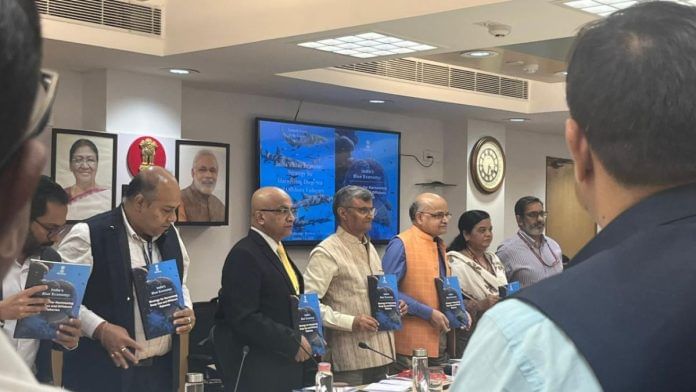New Delhi: India has not fully harnessed the potential of its deep-sea and offshore fishing resources, and continues to be an underperformer in the sector despite having over 11,000 km of coastline, according to a NITI Aayog report.
The report, ‘India’s Blue Economy: Strategy for Harnessing Deep-Sea and Offshore Fisheries‘ was launched Monday by B.V.R. Subrahmanyam, CEO of NITI Aayog.
According to the report, India has only four vessels registered with the Indian Ocean Tuna Commission that are available for high-sea fishing, whereas countries like Sri Lanka and Iran have 1,883 and 1,216 vessels respectively, registered for fishing in the Indian ocean.
“In the last 20 to 30 years, we are using boats with motors attached to it that can only fish up to maximum of 30 to 40 miles from the coastline and not beyond,” said Subrahmanyam, adding that while India exports around $8 billion worth of fishing and marine products, 80 percent of these are aquaculture (grown on a farm on land) and only 20 percent open sea fish.
The report states that there is significant untapped potential for India’s deep-sea and offshore fishing sector, with an estimated resource potential of around 7.16 million tonnes (MT) in 2018, including both conventional (74 percent) and non-conventional resources (26 percent).
For context, territorial waters are 12 nautical miles from the coastline on which a nation has full sovereignty, whereas exclusive economic zones (EEZ) extend beyond 12 nautical miles to 200 nautical miles, over which a country has sovereign rights but not full sovereignty.
The report specifically highlights India’s underperformance in the EEZ area and beyond.
According to the report, one of the key challenges facing India’s fisheries sector is the lack of specific regulations for fishing in EEZs. This means, Indian fishing vessels are operating in the EEZ and the area beyond national jurisdiction (beyond 200 nautical miles) without proper legal authorisation or protection from India.
“This regulatory gap has contributed to issues of illegal, unreported, and unregulated fishing,” the report states. “Further, maritime states are currently limited to issuing licences only for fishing activities within the 12 nautical mile territorial waters.”
The federal think tank has recommended a “comprehensive legislation for the regulation of fishing in the EEZ, to clearly define responsibilities of the nodal agency overseeing the EEZ management”.
According to the report, existing guidelines by India’s Merchant Shipping (MS) Act, 1958, for the registration, survey, and certification of Indian-flagged fishing boats are outdated as they allow registration of vessels that will ply only up to 12 nautical miles from the coast.
NITI Aayog recommends having a separate “Vessels Act” that would allow registration of modern fishing vessels capable of going beyond 12 nautical miles and in deep-sea areas.
Addressing these regulatory gaps is crucial for the sustainable development of India’s deep-sea fisheries sector, the report suggests.
To fully realise the potential of India’s deep-sea and off-shore fishing, the NITI Aayog report recommends a three-phase strategy at a cost of Rs 8,330 crore that could be financed through centrally-sponsored and central sector schemes related to fisheries.
In Phase 1 (2025-2028), the focus would be on laying the foundation of regulatory framework—developing rules and regulations of fisheries governance within the 12 to 200 nautical miles region. Also, focusing on infrastructure development, 10-15 minor deep-sea landing centres need to be established in coastal states/UTs. Under this phase, the potential of deep-sea and offshore fisheries resources need to be mapped.
Under Phase 2, which would extend from 2029 to 2032, there must be large-scale induction of advanced deep-sea and offshore fishing vessels through cooperative ownership models. The report also suggests integrating technology and automation throughout the value chain to enhance efficiency and transparency.
In Phase 3 (2033 and beyond), NITI Aayog report suggests “consolidating the gains made through phases 1 and 2, ensuring long-term sustainability, and positioning India as a global leader in sustainable deep-sea and offshore fishing practices”.
In this phase, the focus must be on high-value product development, sustainability, trade facilitation and strengthening research and development areas.
According to Subrahmanyam, by the end of the third phase, “we should be achieving global scale and moving towards the journey of Aatmanirbhar Bharat in the fisheries sector”.
(Edited by Viny Mishra)
Also read: Vegetarian Haryana is leading fish revolution—Katla, Rohu, Mrigal, Pangas, Shrimp






